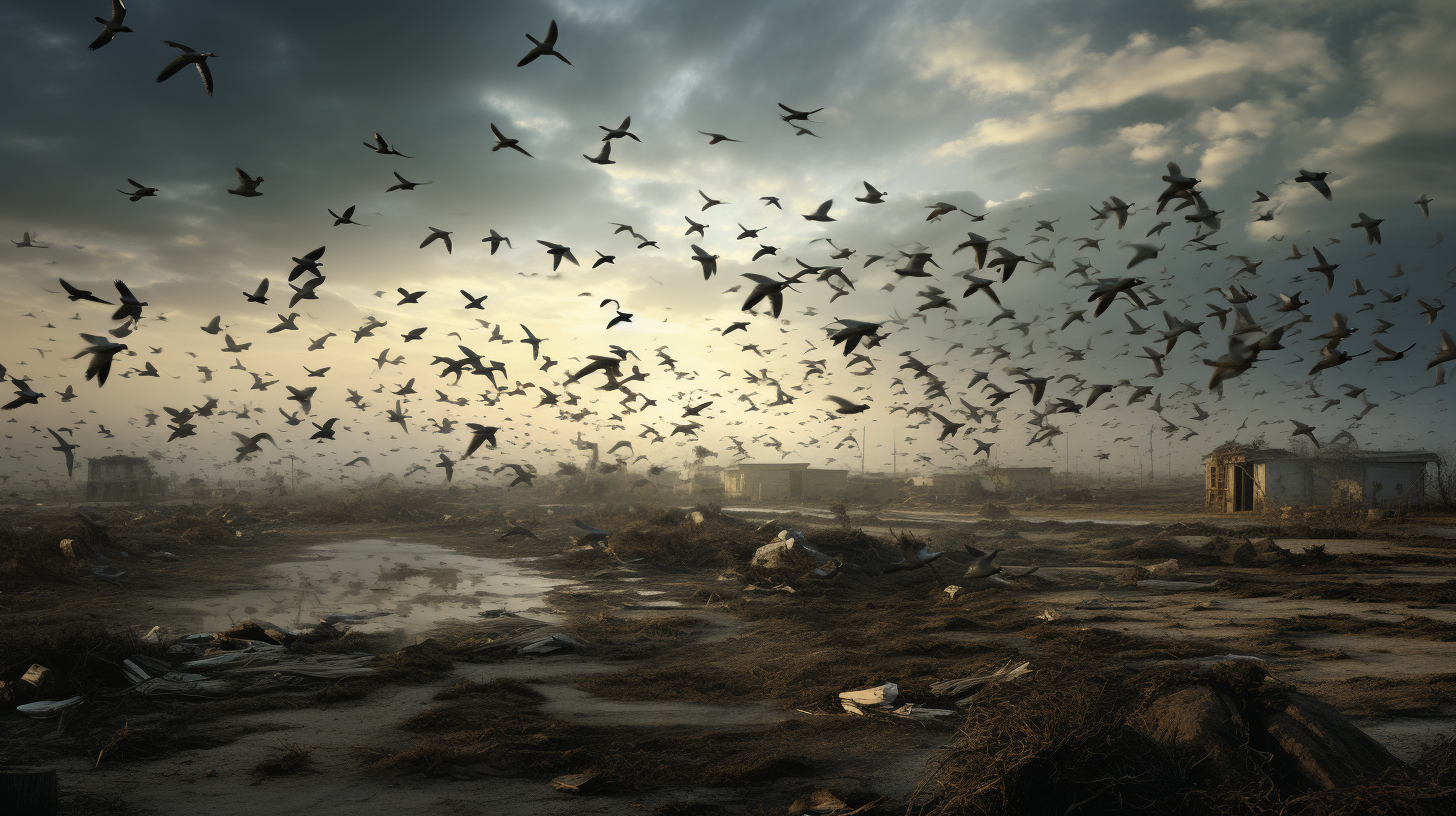Amidst the desolate landscape, where verdant fields have ceded their vibrancy to the relentless march of desertification, there lies an uncanny phenomenon that bewilders the mind and confounds the senses. Welcome to the grim yet fascinating tableau of ‘Migratory Miracles: The New Flight Paths of Displaced Species’—a testament to nature’s desperate bid for survival in a world irrevocably marred by anthropogenic desolation.
In this apocalyptic reverie, one cannot help but marvel at the indomitable spirit of migratory birds, butterflies, and bees, whose instinctual pathways in the sky have been redrawn by the invisible hand of environmental turmoil. Their ancient, once-predictable routes have fractured, splitting the sky into a kaleidoscope of perpetual uncertainty.
With the polar ice caps dissolving into myth, the Arctic tern’s legendary voyage now extends to surreal new latitudes, seeking a breeding ground that isn’t submerged beneath the remorseless waves. Monarch butterflies, once a familiar sight in the gardens of North America, have defected en masse to pockets of hospitable climates, finding solace in areas historically too frigid for their survival but that now offer a balmy refuge from the scorching lands they once called home.
Beneath the chaos, a glimmer of morbid fascination resides. Zoologists and ecologists pore over fresh data with equal parts awe and horror, documenting the emergent patterns of flight that seem to echo a dystopian rendition of connect-the-dots. Honeybees, whose dance once told the tale of plenty, now weave through the air in erratic spirals, a visual metaphor for the disarray inflicted upon their world.
Illustrative of this dire migratory metamorphosis are the desperate adaptations that have emerged. Birds such as the once-coastal albatross now haunt inland areas, their cries a ghostly reminder of oceans swelling and taking with them the costal livelihoods of both man and fowl. Reports trickle in of hummingbirds, with their jeweled throats glittering with defiance, visiting feeders in regions so unfamiliar that the residents gaze upon them as omens. It’s a relentless uprooting sparked not by natural selection but by mankind’s insidious fingerprint.
In undulating waves, the airborne denizens have become nomads of necessity, painting the skies with erratic strokes. Their trajectories are scribbled lines of desperation, a poignant defiance against a backdrop that mutters the final eulogy of lost ecosystems. As glaciers retreat into the realm of lore, species adaptation stands as both a beacon of despair and a stark warning of the consequences dealt by human hands.
Yet, the resilient few who chart these new heavens also kindle a forbidden fire of awe, commanding the gaze of those among us who still dare to seek beauty among ruins. Their migratory feats, an interwoven tapestry of survival and sacrifice, write a riveting narrative against the bleak canvas of our once-bountiful Earth. One cannot help but wonder if, amidst such turmoil, such defiance might whisper secrets of endurance, teaching us lessons from within the eye of desolation.
With each wingbeat against the smog-choked domains, with every flutter above parched basins where rivers once wound, a story of adaptation unfolds. It is a breathtaking odyssey of evolution in real-time; a fervid declaration that life persists even as the foundation crumbles. Yet, these feats are pyrrhic at best—a mere biological echo of the prosperity that now exists only in the annals of yesteryears.
As we bear witness to the silent ballet of migrants tracing invisible lifelines across the sky, we are compelled to confront the magnitude of our own legacy. The deranged choreography of survival, spun across the firmament, serves as a stark illumination of our stewardship’s frailty. It is a mirror reflecting the aberration of our own making—a world where the miraculous has become a symptom of the morose condition we have engineered.
In conclusion, as the evening sun dips below the horizon, silhouetting the stark figures of displaced flocks against a matte sky, the message they bear is heavy with irony. They endure, adapt, and overcome, while the architects of their plight—the collective we—grapple with the shadows of an uncertain future, ignorant of the fact that salvation could very well have been etched within the winged odysseys above.
